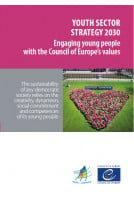Youth work, coupled with effective government policies, is invaluable in ensuring that young people are given the opportunity to acquire the knowledge, skills and attitudes they need for civic engagement and social action.
Youth work is experiencing a policy momentum at European level. Since the adoption of a resolution on the subject by the Committee of Ministers of the Council of Europe in 2017, youth work is back on the core agenda of the Council of Europe and the European Union youth strategies.
This book looks at how youth work practitioners learn their trade, what formal and non-formal education offers exist and how education iscontextualised in the broader picture of youth work recognition. Starting with the premise that formal education entails a series of steps from which youth work practitioners would benefit, this books explores that picture through a mapping study and delves further into its findings through thematic contributions.
The results of the research and debates with policy makers, researchers, practitioners, educators and other stakeholders identifies a field of growing opportunities across Europe. The situation of youth workers in different countries varies from advanced practice architectures for youth worker education to those in need of development. Youth worker education, however, is not only about the education and training offers, it is also about financial and organisational resources, legislation, support systems, competence frameworks, quality standards, ethical frameworks and guidance. This book aims to support youth work so that it becomes more visible and evolves into a recognised field of practice among other occupations and professions engaging with young people.
Chapter 1 – Introduction: education, learning and practice of youth work under the lens
Marti Taru, Ewa Krzaklewska and Tanya Basarab
Chapter 2 – Mapping the educational and career paths of youth workers
James O’Donovan (ed.), David Cairns, Madalena Sousa and Vesselina Valcheva Dimitrova
Chapter 3 – Diversity of practice architectures: education and career paths for youth workers
Tomi Kiilakoski
Chapter 4 – What do you see? A look at youth work through the prism of sociology of occupations
Marti Taru
Chapter 5 – Ethical standards in youth work and how they support the development of education and career pathways of youth workers
Sladjana Petkovic and Ondřej Bárta
Chapter 6 – Mapping youth studies curricula: what is formal education in the field of youth studies saying about young people?
Marko Kovacic, Nikola Baketa and Marita Grubisic-Cabo
Chapter 7 – Early career perspectives on the educational pathways of youth workers
Tomi Kiilakoski
Chapter 8 – Youth workers’ competences and learning in non-formal training
Dunja Potočnik and Marti Taru
Chapter 9 – Associations, networks and support for youth workers in Europe
James O’Donovan
Chapter 10 – Youth workers in the making: youth work practice, learning and education
Marti Taru, Ewa Krzaklewska and Tanya Basarab
CONTRIBUTORS
FIGURES
Figure 1. Other forms of national recognition of youth work
Figure 2. Availability of formal and non-formal education to youth workers
Figure 3. Existence of quality assurance and competence-based tools
Figure 4. Most common competences based on a 10-country analysis
Figure 5. Existence of associations of youth workers and/or networks of youth organisations or centres
Figure 6. Existence of Standard Occupational Profiles for youth workers
Figure 7. Strong practice architectures, group 1: well developed
Figure 8. Strong practice architectures, group 2: with room for development
Figure 9. Practice architectures, group 3: partly developed
Figure 10. Practice architectures, group 4: in need of development
Figure 11. Years of experience and years of training in youth work (n=34)
Figure 12. Assessment of youth workers’ competences using the Council of Europe Youth Work Portfolio framework
Figure 13. Areas of training provided by the organisations that youth worker trainers and managers currently work with (n=25 or 26, depending on
function)
TABLES
Table 1. Overview of focus group interviews
Table 2. Overview of surveys
Table 3. Regulation of youth work as a profession
Table 4. The discourse-cultural arrangements of youth work (second half of 2017)
Table 5. Economic-material arrangements for youth work
Table 6. Associations for youth work
Table 7. Summary of the findings
Table 8. Highest level of education of youth workers (n=215; weighted data)
Table 9. Educational backgrounds of youth workers (n=215; weighted data)
Table 10. Formal education and non-formal learning backgrounds of youth workers
Table 11. The list of reviewed documents
Table 12. The relationship between the number of years of non-formal learning and the number of years of experience in the field (column %, n=34)
Table 13. Areas of potential impact of competence frameworks in the youth field (n=29)
Table 14. Tools and instruments used or recommended by youth worker trainers and managers for competence self-assessment (n=17)
Table 15. Proposed improvements at organisational, local, national and European levels in providing youth workers with opportunities to obtain
competences for quality youth work (n=28)
Table 16. Support offered to youth workers to acquire competences (n=29)










